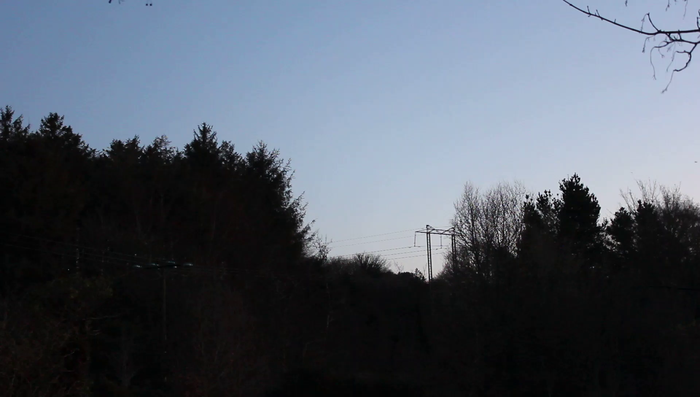On cold, dark winter mornings, small black crows known as jackdaws can be heard calling loudly to one another from their winter roosting spots in the U.K. before taking off simultaneously right around sunrise. Now, researchers who’ve studied their daily activities in unprecedented detail report evidence that these groups of hundreds of individuals rely on a “democratic” decision-making process to coordinate with one another and take to the skies all at once. The findings are reported in the journal Current Biology on May 23.

Credit: Dibnah et al./Current Biology
On cold, dark winter mornings, small black crows known as jackdaws can be heard calling loudly to one another from their winter roosting spots in the U.K. before taking off simultaneously right around sunrise. Now, researchers who’ve studied their daily activities in unprecedented detail report evidence that these groups of hundreds of individuals rely on a “democratic” decision-making process to coordinate with one another and take to the skies all at once. The findings are reported in the journal Current Biology on May 23.
“Like humans, large animal groups can use decision-making processes to overcome their individual differences and reach a kind of ‘democratic’ consensus,” says Alex Thornton (@CornishJackdaws) of the University of Exeter.
Previous studies had investigated consensus decision-making in animal groups that were relatively small or made up of family members, he explained. What struck them about the jackdaw roosts was their sheer size. Not only are their groups large, they also include individuals of different ages, sexes, family groups, and colonies all spread across the treetops.
It’s not likely that all those different individuals would just naturally prefer to take off at precisely the same moment. And, yet, sticking together has advantages, such as reducing the risk of predation and giving individuals information from their peers about where to find food. The researchers wanted to explore how the birds decide when it is time to go.
To look more closely, Thornton and colleagues, including first author Alex Dibnah (@alexdibnah01), recorded hours and hours of audio and video of six different jackdaw roosts in Cornwall, U.K. over the course of the winter months. The size of the roosts varied from 160 to almost 1,500 individuals. They quantified the intensity of the birds’ calls leading up to and right after they took off in flight.
The evidence shows that the timing of departure is tightly linked to calling intensity within the roost. While on some mornings, the birds left in a stream of small groups over about 20 minutes, most of the time they set out in mass departures, with hundreds of birds taking off within about 4 seconds of each other.
On most mornings, they found that calling intensity increased over the hour before the biggest group departure. It sometimes got delayed by rain or heavy cloud cover. They concluded that changes in calling intensity could serve as a reliable source of information, enabling the birds to synchronize their daily takeoffs.
To confirm cause and effect, the researchers played the sounds of conspecifics calling to them to see if they could get the birds to take off earlier than they otherwise would have. And they found that they could. By adding calls into the mix, the birds took flight an average of about 6.5 minutes earlier.
“Through their calls, jackdaws appear to effectively signal their willingness to leave, providing large groups with a means of achieving consensus to perform cohesive, collective departures from the roost,” the researchers write.
They say the observational data indicate that consensus is achieved as the intensity of calls build to a point that triggers them to act. The playback experiments help to show a causal link between calling intensity and takeoff. Together, they offer new insight into the ways that animals make decisions about mass movements in nature.
It is also notable that, on the few occasions when the intensity of calling did not build up sufficiently, the birds apparently failed to reach consensus. As a result, they took off in “dribs and drabs” instead of all at once.
In future studies, researchers hope to learn more about how human activities may affect these dynamics.
“As human impacts on wildlife grow, we are very interested in understanding to understand whether and how human disturbance—for instance, from light and noise pollution—may affect animal groups’ abilities to communicate and reach consensus decisions,” Thornton says.
###
This research was supported by the Swedish Research Council, the Human Frontier Science Program, the Whitten Lectureship in Marine Biology, the Royal Society Dorothy Hodgkin Research Fellowship, and a Severo Ochoa Postdoctoral grant through the Spanish Program for Centres of Excellence.
Current Biology, Dibnah et al. “Vocally mediated consensus decisions govern mass departures from jackdaw roosts” https://www.cell.com/current-biology/fulltext/S0960-9822(22)00601-7
Current Biology (@CurrentBiology), published by Cell Press, is a bimonthly journal that features papers across all areas of biology. Current Biology strives to foster communication across fields of biology, both by publishing important findings of general interest and through highly accessible front matter for non-specialists. Visit http://www.cell.com/current-biology. To receive Cell Press media alerts, contact [email protected].
Journal
Current Biology
DOI
10.1016/j.cub.2022.04.032
Method of Research
Experimental study
Subject of Research
Animals
Article Title
Vocally mediated consensus decisions govern mass departures from jackdaw roosts
Article Publication Date
23-May-2022




